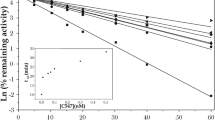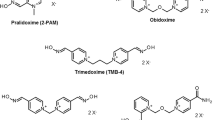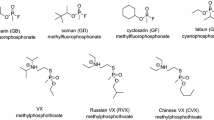Abstract
Propoxur with a non-toxic dose (5 mg/kg) administered intraperitoneally (ip) in tetraisopropylpyrophosphoramide (iso-OMPA, 1 mg/kg) pretreated rats subcutaneously, sc) produced severe intoxication of anticholinesterase nature. The observed severity was comparable to that caused by an acute sublethal dose of propoxur (15 mg/kg) suggesting at least threefold potentiation of toxicity. Either drug given alone produced neither signs of toxicity nor alterations in acetylcholinesterase (AChE) activity, while carboxylesterase (CarbE) activity was markedly reduced indicating tremendous nonspecific binding. The administration of iso-OMPA followed by propoxur elicited inhibition of AChE to a critical level and produced severe intoxication. These results suggested that iso-OMPA induced potentiation of propoxur toxicity stemmed through irreversible inhibition of CarbE.
Similar content being viewed by others
References
Dettbarn W-D, Gupta RC (1989) Role of esterases as false targets in organophosphorus compounds toxicity. In: Reiner E, Aldridge WN, Hoskin FCG (eds) Enzymes hydrolyzing organophosphorus compounds. Ellis Horwood Publishers. Chichester, England, pp 165–179
Earl CJ, Thompson RHS, Webster GR (1953) Observations on the specificity of the inhibition of cholinesterases by tri-o-cresylphosphate. Br J Pharmacol 8:110–114
Gupta RC, Kadel WL (1989) Concerted role of carboxylesterases in the potentiation of carbofuran toxicity by iso-OMPA pretreatment. J Toxicol Environ Hlth 26:447–457
Gupta RC, Patterson GT, Dettbarn W-D (1985) Mechanisms involved in the development of tolerance to DFP toxicity. Fundam Appl Toxicol 5:S17-S28
Hestrin S (1950) The reaction of acetylcholine and other carboxylic acid derivatives with hydroxylamine, and its analytical application. J Biol Chem 180:249–261
Miyaoka T, Takahashi T, Tsuda S, Shirasu Y (1984) Potentiation of acute toxicity of 2-sec-butylphenylN-methylcarbamate (BPMC) by fenitrothion in mice. Fundam Appl Toxicol 4:802–807
Myers DK, Mendel B (1949) Investigations on the use of eserine for the differentiation of mammalian esterases. Proc Soc Exp Biol Med 71:357–360
O'Brien RD (1967) Insecticides, action and metabolism. Academic Press, New York, pp 83–107
Steel RGD, Torrie JM (1980) Principles and procedures of statistics. McGraw-Hill, New York, pp 187–188
Sterri SH, Lyngas S, Fonnum F (1981) Toxicity of soman after repetitive injection of sublethal doses in guinea pig and mouse. Acta Pharmacol Toxicol 49:8–13
Takahashi H, Kato A, Yamashita E, Naito Y, Tsuda S, Shirasu Y (1987) Potentiations ofN-methylcarbamate toxicities by organophosphorus insecticides in male mice. Fundam Appl Toxicol 8:139–146
Takahashi H, Miyaoka T, Tsuda S, Shirasu Y (1983) Combined toxicity of malathion and carbamate insecticides in mice and rats. J Pestic Sci 8:41–45
Tsuda S, Miyaoka T, Iwasaki M, Shirasu Y (1984) Pharmacokinetic analysis of increased toxicity of 2-sec-butylphenyl methylcarbamate (BPMC) by fenitrothion pretreatment in mice. Fundam Appl Toxicol 4:724–730
Author information
Authors and Affiliations
Rights and permissions
About this article
Cite this article
Gupta, R.C., Kadel, W.L. Toxic interaction of tetraisopropylpyrophosphoramide and propoxur: Some insights into the mechanisms. Arch. Environ. Contam. Toxicol. 19, 917–920 (1990). https://doi.org/10.1007/BF01055061
Received:
Revised:
Issue Date:
DOI: https://doi.org/10.1007/BF01055061




